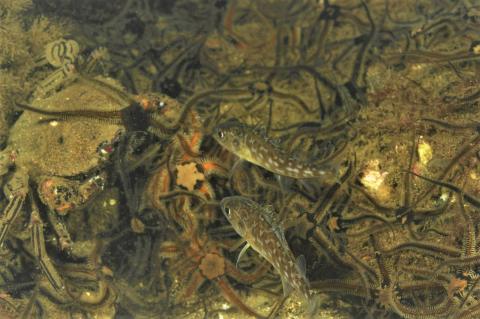
- Increases in warm-water fish species in UK waters continue to be observed, along with local declines of some cold-affinity species.
- Research continues to support the hypothesis that temperature changes are affecting fish growth and age at maturation in UK waters.
- New experimental studies have shown that fin-fish larvae may be sensitive to changes in ocean acidification, but different species have shown a variety of responses.
- Several species of cephalopods have shown noticeable increases in abundance and geographical spread in UK waters, a change consistent with warming waters.
- Recent evidence supports the hypothesis that reproductive success in Atlantic cod is negatively impacted at temperatures above 9.6°C.
High evidence, medium agreement
Since the last MCCIP assessment in 2020 (Wright et al., 2020), further studies have been published on the changing distribution of species in UK waters, although there remains limited information on the impact of heat waves, although see Wakelin et al. (2021) for a study linking extreme thermal events with fisheries landings. We have also been unable to find any studies on the effects of observed pH changes on fish in UK waters. Nevertheless, fish and fisheries biology research have remained one of the most active fields in marine science so the amount of available evidence remains ‘High’ but, because of uncertainty in areas such as food- web and acidification responses, the level of agreement and consensus is still judged as being ‘Medium’. Consequently, the overall assessment has not changed from the 2020 MCCIP Report Card.
- Ocean temperatures are expected to continue to rise and will affect species composition and abundances, particularly in shallower areas such as the southern North Sea.
- Shifts in food-webs may occur due to changes in species composition and abundances affecting predator-prey relationships.
- For important commercial species, such as cod, areas such as the northern North Sea will remain suitable habitat throughout the coming century but more southern areas will become less suitable.
- Such sub-regional effects will need to be taken into account in fisheries management plans and advice, and this may require changes in the spatial scales at which data are collected, reported and analysed in the coming decades.
- By end of century, conditions could become favourable for warm-water species such as Mediterranean horse mackerel and bogue as far north as the middle of the Irish and North Seas.
- Experiments have suggested that effects from ocean acidification and oxygen depletion could lead to stress in some species under conditions expected by end of century but impacts on wild fish populations are hard to predict as only a limited range of species have been studied so far.
Medium evidence, medium agreement
There are a range of marine ecosystem models which attempt to capture much of the uncertainty about marine ecosystem structure and function, however, the amount of evidence remains at ‘Medium’. Although the likely broad responses to temperature increase are known, the level of consensus remains as ‘Medium’ because of uncertainties over the “magnitude” of responses throughout the food web. In addition, the number of ecosystem models which can incorporate both climate change projections and can conduct ensemble exercises is still limited for UK seas.
The three top priority challenges for providing improved advice on fish responses to climate change identified in Wright et al. (2020) were (1) contribution, (2) multi-level data integration, and (3) model testing. This update has identified some further, but limited progress as reported in the scientific literature. Research funding has become a serious problem with post-Brexit restrictions on EU funding and with resources in fisheries laboratories being diverted to issues such as offshore renewables and marine protected areas. Our perception is that this has led to a decrease in basic fish and shellfish biology and ecological studies. This is undesirable as robust projections of climate-related changes in productivity and distribution of fish still require better integration of data on survival, distribution, movements, aerobic scope, growth and reproductive schedules into statistical, process-based and ecosystem models.
Even though the range of marine ecosystem models available is increasing, we still need to make the best use of these models either through ensemble approaches (Spence et al., 2021) or through the complementary inclusion of food web models with non-mechanistic models (Coll et al., 2019). Rather than trying to choose the “best” model, or taking some weighted average, it is important to exploit the strengths of each of the types of models, whilst learning from the differences between them and finding ways to generalize their outcomes to strengthen projections under a range of climate scenarios.
The need for validation of model assumptions remains as does the need to consider habitat dependency, integration of physiological processes and the combination of individual and population level data to understand the nature of climate responses. Identifying bottlenecks where species may be most sensitive to climate change, such as shallow coastal nursery areas, remains important. Although studies have tended to focus on commercial species, climate change may also affect non-commercial species of conservation importance to the UK (e.g. flapper skate, Dipturus intermedius and basking shark, Cetorhinus maximus). Such impacts would have implications for the effectiveness of existing and proposed marine conservation measures so that non-commercial species should not be ignored in setting marine climate research priorities.